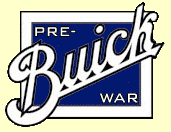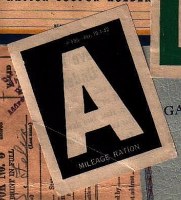 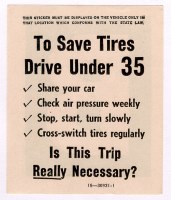 “What does the 'A' mean?” someone will ask, pointing to the paper sticker in the window of my 1938 Buick sedan. “What does the 'A' mean?” someone will ask, pointing to the paper sticker in the window of my 1938 Buick sedan.“Gasoline rationing during World War II,” I respond, but there's more to the story. Indeed, the main idea was to conserve rubber, not gasoline. The interior side of the sticker (shown) instructs the driver on this point.
In May of 1942, the U.S. Office of Price Administration (OPA) froze prices on practically all everyday goods, starting with sugar and coffee. War Ration Books were issued to each American family, dictating how much any one person could buy. The first nonfood item rationed was rubber.
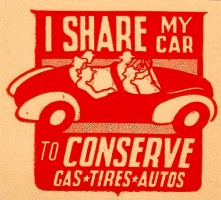 The Japanese had seized plantations in the Dutch East Indies that produced 90% of America's raw rubber. President Franklin D. Roosevelt called on citizens to contribute scrap rubber, “old tires, old rubber raincoats, garden hose, rubber shoes, bathing caps…”. The OPA established the Idle Tire Purchase Plan, and could deny Mileage Rations to anyone owning passenger tires not in use. The national maximum “Victory Speed” was 35 miles an hour. “Driving clubs” or carpools were encouraged. A magazine ad declared, “Your Car is a War Car Now.” The Japanese had seized plantations in the Dutch East Indies that produced 90% of America's raw rubber. President Franklin D. Roosevelt called on citizens to contribute scrap rubber, “old tires, old rubber raincoats, garden hose, rubber shoes, bathing caps…”. The OPA established the Idle Tire Purchase Plan, and could deny Mileage Rations to anyone owning passenger tires not in use. The national maximum “Victory Speed” was 35 miles an hour. “Driving clubs” or carpools were encouraged. A magazine ad declared, “Your Car is a War Car Now.”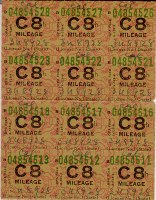 Gasoline was rationed on May 15, 1942 on the east coast, and nationwide that December. The OPA issued various stickers to be affixed to the car's windshield, depending on need. To get your classification and ration stamps, you had to certify to a local board that you needed gas and owned no more than five tires. Gasoline was rationed on May 15, 1942 on the east coast, and nationwide that December. The OPA issued various stickers to be affixed to the car's windshield, depending on need. To get your classification and ration stamps, you had to certify to a local board that you needed gas and owned no more than five tires.The 'A' sticker was issued to owners whose use of their cars was nonessential. Hand the pump jockey your Mileage Ration Book coupons and cash, and she (yes, female service station attendants) could sell you three or four gallons a week, no more. For nearly a year, A-stickered cars were not to be driven for pleasure at all.
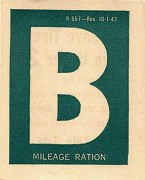 The green 'B' sticker was for driving deemed essential to the war effort; industrial war workers, for example, could purchase eight gallons a week. Red 'C' stickers indicated physicians, ministers, mail carriers and railroad workers, and incidentally were the most counterfeited type. 'T' was for truckers, and the rare 'X' sticker went to Members of Congress and other VIPs. The green 'B' sticker was for driving deemed essential to the war effort; industrial war workers, for example, could purchase eight gallons a week. Red 'C' stickers indicated physicians, ministers, mail carriers and railroad workers, and incidentally were the most counterfeited type. 'T' was for truckers, and the rare 'X' sticker went to Members of Congress and other VIPs.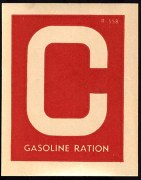 Apparently there was some cheating, but this was socially unacceptable as well as illegal. The Mileage Ration folder warns drivers to write their car's license number on each coupon, “Endorsement Protects You and Helps Lick the Black Market.” Dr. Cecil L. Betz of Los Angeles has done so on his C stamps shown. Apparently there was some cheating, but this was socially unacceptable as well as illegal. The Mileage Ration folder warns drivers to write their car's license number on each coupon, “Endorsement Protects You and Helps Lick the Black Market.” Dr. Cecil L. Betz of Los Angeles has done so on his C stamps shown.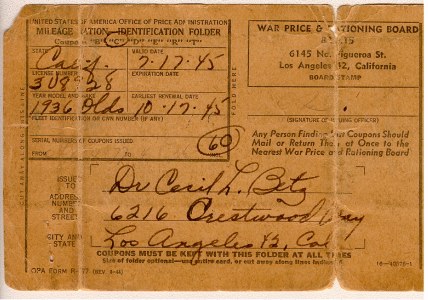 I wonder if Dr. Betz or his '36 Oldsmobile are still around? I wonder if Dr. Betz or his '36 Oldsmobile are still around?
And, in the words of the day, “There's a war on, you know.” Every citizen, military or civilian, was to do their part. Even in the popular Warner Brothers cartoons, Daffy Duck exhorts the audience to “Keep it under 40!”, and Bugs Bunny's plunging airplane halts just before impact, out of gas as a consequence of the `A' sticker on its windshield.
Did rationing work? Generally it did. Consider that in the 1940s the automobile really wasn't the universal appliance it is now, so fuel restriction was probably less onerous to the average civilian than the rationing of other goods. For many who served on the Home Front, rationing may be the most remembered daily aspect of the war.
bbbbb aaaaa
Sources and recommended reading:
Mike Wright, What They Didn't Teach You About World War II, Presidio Press, 1998
Marion Stegemen Hodgson, Winning My Wings, Naval Institute Press, 1996
Stan Cohen, V for Victory, America's Home Front During World War II, 1991
|
